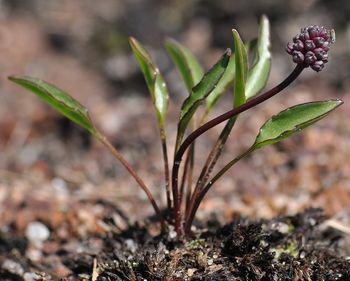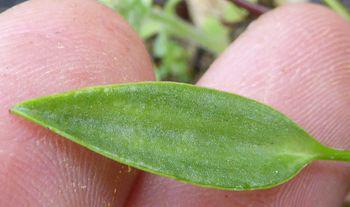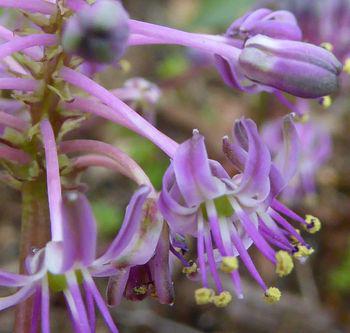Ledebouria remifolia
Ledebouria remifolia S.Venter
Family: Hyacinthaceae
Common names: butterspoon African hyacinth
Introduction
A unique, dwarf, bulbous plant which produces spoon-like leaves on a long slender stalk. This small enigmatic species makes a curious container subject that is easy to grow and maintain.

Description
Description
Dwarf, bulbous plant, usually solitary but often occurring in dense colonies, with small bulbs, 20 × 20 mm, producing 3–7, deciduous, unspotted, dark green leaves, which are located at the end of a long, slender, reddish petiole-like stalk. The leaf stalks and the peduncle (main flower stalk) are reddish, and adorned with longitudinal rows of minute papillae.

The slender, unbranched inflorescence (flower spike), is produced in early spring (August to September in South Africa). It remains erect when in bud, but becomes decumbent once the flowers open.

The individual florets (small flowers) are clustered towards the tip of the peduncle; each floret is attached to the peduncle (main flower stalk) by a curved, purple-coloured pedicel (flower stalk). The reflexed tepals (petals) of the individual florets (small flowers), are mostly pale purple, and often with a greenish stripe down the centre of each tepal. Purple filaments (anther stalks) extend from the mouth of the florets and bear pale yellow anthers, which produce the pollen.

After flowering, the tiny brown seed quickly develops in small, green, 3-lobed capsules, which split open to release the small, dark brown seeds.
Conservation Status
Status
Ledebouria remifolia is assessed as Vulnerable (VU) on Red List of South African plants. It is a rare and localized species, known from only five locations, two of which are at risk from invasive alien plants and mining operations.
Distribution and habitat
Distribution description
The butterspoon African hyacinth is known from a limited number of locations, ranging from Kaapsehoop to near Bourkes Luck in the Mpumalanga Drakensberg, Mpumalanga Province. The species occurs in short, high-altitude grassland, which receives over 2 000 mm of precipitation per year, much of which is in the form of condensation from the frequent mist which bathe the mountain crests. This ledebouria is a component of sparsely wooded grassland on mountain tops. The winters are cold and dry and are often subjected to fire.
Derivation of name and historical aspects
History
Ledebouria remifolia was first described by F.Z. van der Merwe in 1941, as Scilla petiolata. J.P. Jessop subsequently sunk this species under his broader concept of L. cooperii. It was only finally resurrected to full species and correctly placed in the genus Ledebouria by Dr S. Venter, officially in 2008, in his synopsis of the genus.
The genus Ledebouria is named in honour of the German-Estonian botanist, Professor Carl Friedrich von Ledebour (1785–1851). The species name remifolia, is made of two parts; remi- meaning ‘an oar’ in Latin, and -folia which means ‘foliage’ (leaves) in Latin; thus meaning ‘oar-leaved’.
South Africa has 42 species of Ledebouria. The genus is distributed across Africa and India, with the centre of species diversity in the eastern parts of southern Africa.
This species is unlike any other Ledebouria species and thus cannot be confused with any other species because of the unique spoon-shaped leaves presented on a long slender stalk.

Ecology
Ecology
The grasslands where this species occurs, are subjected to fires during the dry cold winter months. The plants are able to escape fire by going dormant, where they remain protected under the soil. The brightly coloured, star-shaped flowers suggest that they are opportunistically pollinated by most visiting insects. The seed is very small compared to other Ledebouria species. Venter (1993) suggests that ledebouria seeds are distributed by water wash.
Uses
Use
No specific references exist in the literature to this species being used by people. The genus Ledebouria as a whole has been used medicinally in Africa,including pregnancy, diarrhoea, influenza, backache, skin irritations, wound treatment, as well as lumbago. The genus is also reported as being poisonous, although it is also reported that Bushmen eat the bulbs of certain other species (L. apertiflora and L. revoluta).
Growing Ledebouria remifolia
Grow
Ledebouria remifolia is easy to maintain in cultivation.I it is most suited to being grown in containers because of its small size and prefers an acidic peaty loam soil. An ideal potting mixture would include 1 part peat (or peat alternative such as palm peat or bagasse), 1 part old, well-rotted compost or sifted cattle manure and 1 part sandy loam. The potting medium should provide a slightly acidic soil environment. Watering should be frequent during the summer months, preferably using rainwater if available. The bulbs prefer a cool, summer climate, with good air circulation, and the soil should be kept moist throughout the growing season. Growing the plants in full sun, ensures a compact growth habit and intensifies the red colouration of the leaves and leaf stalks. During the dry winter dormancy period, the pots should be moved out of the rain and placed in a dry, cool area, with adequate air movement. During the dry winter months, the plants can be very lightly watered once a month, to maintain moisture content in the soil. Watering can commence towards the end of winter at the onset of warmer weather (August–September in South Africa).
Propagation from seed is the best method of producing more plants; the seed must be sown fresh. Sow seeds immediately (do not store them) in spring or summer, in shallow seed trays filled with the sifted potting mixture mentioned above. Sow seed on a firmly tamped surface and lightly cover with the same mixture approximately 1 mm deep. The trays should be kept in a bright position out of direct sunlight and kept damp until germination has commenced. Seedlings can remain in the seedling tray or be planted out as soon as they are large enough to handle. Flowering size bulbs can be attained after 1 to 2 years from germination.
References
- Hankey, A. 2011. Ledebouria Roth. PlantZAfrica. Internet 5 pp. http://pza.sanbi.org/ledebouria-genus
- Lötter, M., Hankey, A.J. & von Staden, L. 2016. Ledebouria remifolia S.Venter. National Assessment: Red List of South African Plants version 2017.1. Accessed on 2017/03/31
- Venter, S. 1993. A revision of the genus Ledebouria Roth (Hyacinthaceae) in South Africa. Unpublished M.Sc. thesis, University of Natal, Pietermaritzburg.
- Venter, S. 2008. Synopsis of the genus Ledebouria Roth (Hyacinthaceae) in South Africa. Herbertia 62
- Website: Latdict. http://latin-dictionary.net
Credits
Andrew Hankey
Walter Sisulu National Botanical Garden
March 2017
Plant Attributes:
Plant Type: Bulb
SA Distribution: Mpumalanga
Soil type: Sandy, Loam
Flowering season: Spring
PH: Acid
Flower colour: Purple
Aspect: Full Sun
Gardening skill: Easy
Special Features:
Horticultural zones









Rate this article
Article well written and informative
Rate this plant
Is this an interesting plant?
Login to add your Comment
Back to topNot registered yet? Click here to register.